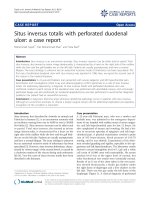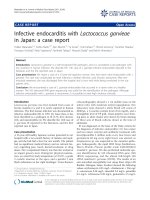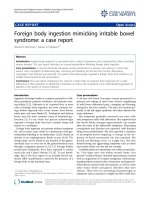Báo cáo y học: " Primary central nervous system lymphoma presenting as a pure third ventricular lesion: a case report" pps
Bạn đang xem bản rút gọn của tài liệu. Xem và tải ngay bản đầy đủ của tài liệu tại đây (2.15 MB, 5 trang )
CAS E REP O R T Open Access
Primary central nervous system lymphoma
presenting as a pure third ventricular lesion:
a case report
Mehdi Sasani
1*
, Muzaffer Bayhan
2
, Hadi Sasani
3
, Tuncay Kaner
1
, Tunc Oktenoglu
1
, Gokhan Cakiroglu
4
and
Ali Fahir Ozer
1
Abstract
Introduction: Primary central nervous system lymphomas are infrequently occurring lymphomas that account for
only 0.3-1.5% of all intra-cranial neoplasms in patients without acquired immune deficiency syndrome. However, a
pure third ventricle lymphoma is extremely rare. Here, we discuss the similar radiological appearances of lesions
localized in the third ventricle and the importance of accurately diagnosing primary central nervous system
lymphomas for favorable treatment outcomes.
Case presentation: A 38-year-old Caucasian man from Turkey presented with a severe headache lasting for three
months that failed to respond to any medication. Both severity and duration of the symptoms increased gradually,
resulting in vomiting, nausea and gait disturbance that accompanied the headache for three weeks. Neuro-imaging
studies showed a lesion located solely in the third ventricle, resulting in partial obstruction of the foramen of
Monro. The pre-operative diagnosis was a colloid cyst. Following the surgical procedure, the results of pathological
and immunochemical assays revealed that the pre-operative diagnosis was incorrect and that the lesion was a
primary central system lymphoma.
Conclusion: Pure third ventricl e lymphomas are extremely rare and are exceptionally localized. It is important to
be aware of, and to differentiate between, other possible third ventricular lesions that may mimic the same
radiological appearance. Accurate diagnosis is necessary for selecting appropriate treatment modalities.
Introduction
Primary central nervous system lymphomas (PCNSL)
are infrequently occurring lymphomas that account for
only 0.3-1.5% of all intra-cranial neoplasms in patients
without acquired immune def iciency syndrome (AIDS)
[1,2]. Patients with AIDS, congenital immune deficien-
cies and those undergoing organ tra nsplantations are at
a greater risk of developing this condition. The most
common localization sites of PCNSL (both B and T
cell s type) are in the supra-tento rial white matter of the
frontal parietal lobes [3].
Here we report an unusual PCNSL involving only the
third ventricle. Indeed, few cases have been reported in
the literature. We will also discuss other more common
third ventricle masses that may mimic the radiological
characteristics of PCNSL.
Case Presentation
A 38-year-old male (Caucasian) patient from Turkey pre-
sented with a persis tent severe headache wit h a duration
of approximately thr ee months. Both the sever ity and
duration of the symptoms increased gradually during this
time. Vomiting, nausea, and temporary gait disturbance
were present during the three weeks leading up to his hos-
pital visit. According to hi s cl inical history, his headache
did not respond to any prescribed medication, and his
complaints did not correspond to a specific posture.
Hematological parameters were within normal limits, and
the serological test for human immunodeficiency virus
was negative. Visual field and visual quality were tested
with standard clinical finger confrontation. The results of
testswerefreeofabnormalfindings.Afundoscopic
* Correspondence:
1
American Hospital Neurosurgery Department, Nisantasi, Istanbul, Turkey
Full list of author information is available at the end of the article
Sasani et al. Journal of Medical Case Reports 2011, 5:213
/>JOURNAL OF MEDICAL
CASE REPORTS
© 2011 Sasani et al; licensee BioMed Central Ltd. This is an Open Access article distributed under the terms of the Creative Commons
Attribution License (http://creativecom mons.org/licenses/by/2.0), which permits unrestrict ed use, distribution, and reproduction in
any medium, provided the original work is properly cited.
examin ation revealed that his optic disc margins, ratio of
artery to vein sizes and venous pulsation were within nor-
mal limits. Mid-line cerebellar function was tested by hav-
ing our patient walk on a straight line, and hemispheric
cerebellar function was tested by having our patient per-
form rapid alter nating movements and by rapid ly having
him touch his nose or the physician’s moving index finger.
The examinations of cerebellar, ganglionic, and cortico-
spinal pathways were all normal. The results of all of these
neurological examinations were wit hin normal limits and
suggested that our pa tient did not have any symptoms of
neurological disturbance. To identify the underlying
pathology, magnetic resonance imaging (MRI ) was per-
formed. This examination revealed that the third ventricle
was completely filled with a mass-like lesion that was
hypointense on T1-weighted scans and hyperintense on
T2-weighted scans. The lesion was partially obstructing
the foramen of Monro; however, it did not cause severe
hydrocephalus (Figure 1). Our patient underwent surgery
for a craniotomy.
An intra-hemispheral transcallosal approach was per-
formed, allowing access to his right ventricle and the
foramen of Monro. Due to tumoral expansion, the fora-
men of Monro was dilated. Although analysis of a fro-
zen section was consistent with PCNSL, the t umor was
completely resected without complication.
Histopat hological examination revealed increased lym-
phoma sheets of round cells with small to moderate
amounts of cytoplasm (Figure 2). Our patient underwent
a staging evaluation that included a whole-body positron
emission tomography/computed tomography (PET/CT)
scan, bone marrow biopsy and analysis of blood chemis-
try. All of these procedures failed to reveal any abnorm-
alities. The PET/CT scan showed a slight accumulation
of 2-[
18
F] fluoro-2-deoxyglucose in the original location
of the tumor.
A post-operative cranial computed tomography (CT)
scan concluded soon after surgery revealed a hematoma
in the third ventricle (Figure 3). The neurological
examination was free of symptoms. Follow-up CT scans
were conducted and revealed a blood clot that
obstructed the foramen of Monro, resulting in hydroce-
pha lus. However, the follow-up cranial CT scan did not
show the hydrocephalus, which indicated that the hema-
toma was no longer present. Our patient refused all
treatment options except corticosteroids. A follow-up
crani al MRI conducted six months after surgery showed
that the lymphoma had not reoccurred (Figure 4). Our
patient was available for follow-up after one year.
Discussion
PCNSLs are infrequent tumors that account for 0.7-0.9%
of all lymphomas and only 0.3-1.5% of intra-cranial
tumors [1]. These can occur in both immune-competent
and immune-compromised patients [1]. Reports suggest
that this type of lymphoma occurs more commonly in
menthanwomen,inaratioof3:2(men:women)[1,4].
Intr a-cranial lymphomas are diagnosed using both mor-
phological criteria and immunohistochemical reactions
[5]. Most primary i ntra-cranial lymphomas are com-
prised of non-Hodgkin’s B-cells [6]. Cerebrospinal fluid
analysis yields a cytological diagnosis in fewer than half
of patients with B-cell PCNSL. Neuro-imaging modal-
ities can also reveal solitary lesions, which are most
comm only located supra-tento rially, in the white matter
of the frontal or parietal lobes or in the sub-ependymal
regions. However, lesions may also appear in the deep
gray matter [3]. Typically, these lesions are in the cen-
tral gray matter (33%), the basal ganglia-thalamus-
hypothalamic region (17%), the cerebral white matter
near the corpus callosum (55%), the posterior fossa
(11%) and the peri-ventricular region. Fewer than 1% of
cases reported occurred within the spinal cord [1,6,7].
TheinvolvementofthethirdventricleinPCNSLcases
is quite rare and thus is considered to be exceptional. B-
cell primary intra-cranial lymphoma typically presents in
patients approximately 50 years of age and is more com-
mon in male pati ents [6]. The patient may present with
Figure 1 A pre-operative cranial MRI showing the primary lymphoma (arrow), which was solely located in the third ventric le (small
arrows).
Sasani et al. Journal of Medical Case Reports 2011, 5:213
/>Page 2 of 5
a large variety of symptoms, such as an a lteration in
mental status, followe d by nause a, headache, hemipar-
esis, alterations in cerebellar function , cranial nerve pal-
sies and visual deterioration [6,8].
The findings from radiological imaging of the third
ventricular lymphoma can easily be confused with other
more common lesions t hat share the same localization
[9], including a colloid cyst, cranio-pharyngioma,
hypothalamic and thalamic glioma, ependymoma, basilar
tip a neurysm and neuro-cytoma. An MRI is very useful
for differentiating intra-cranial masses, particularly from
cystic lesions such as a colloid cyst. Unfortunately the
radiographic description of PCNSL is poor at best, espe-
cially given the sporadic and limited involvement of t he
cerebrospinal fluid and vitreous matter.
Ueda et al. [10] reported that all lesions showed
hypointensity in MRI T1-weighted images, whereas
three lesions showed definite hypointensity to gray mat-
ter and others showed hyperintensity in T2-weighted
images. There was, however, no pathological difference
between the hyperintensive and hy pointensive lesions in
the T2-weighted images. In addition, Gualdi et al. [11]
demonstrated that neoplas tic proc esses localized on the
floor of the third ventricle are frequently responsible for
neurological and dysendocrine symptoms. Furthermore,
the results of this study suggest that CT and MRI stu-
dies are the most reliable neuro-imaging techniques for
the diagnostic a nd surgical management of neoplastic
masses affecting this region.
Treatment for intra-cranial lymphoma can include
chemotherapy, radiotherapy (RT), surgery and a combi-
nation of these treatment modalities [12]. In the present
case, our patient refused all treatments except corticos-
teroids. Corticosteroid treatment typically leads to a sig-
nificant tumor regression that is often associated with
clinical improvement [13]. The n euro-imaging response
can be dramatic, sometimes showing complete remission
of contrast-enhancing abnormalities. Most responses,
however, are temporary, although complete remission
has been reported [14].
Figure 2 Histopathological examination showed incr eased lymphoma sheets of round cells with small to moderate amounts of
cytoplasm (black arrows).
Sasani et al. Journal of Medical Case Reports 2011, 5:213
/>Page 3 of 5
In this case, the pre-operative diagnosis based on the
findings of an initial MRI inco rrectly indicated that the
lesion was a colloid cyst. The accurate post-operative
diagnosis, however, was PCNSL, which is rarely observed,
particularly if it is a pure third ventricle lymphoma. It is
essential to note that if the pre-operative diagnosis had
been correct, unnecessary surgical procedures may have
been avoided, and the patient’ s treatment might have
been more appropriate (that is, steroid therapy, radio-
the rapy or chemotherapy). Indeed, PCNSL is sensitive to
steroids (40% combined with RT) and is highly radiosen-
sitive (80-90%) [15].
Conclusion
Pure third ventricle lymphomas are extremely rare and
do not normally occur with exceptional localization.
Thus, for proper diagnosis, it is important to differenti-
atebetweenotherpossiblethirdventriclelesionsthat
may mimic the radiological appearan ce of su ch lympho-
mas. It is equally important to obtain accurate diagnos-
tic results because the correct differentiation determines
treatment options.
Consent
Written informed consent was obtained from the patient
for publicatio n of this case report and any accompany-
ing images. A copy of the written consent is available
for review by the Editor-in-Chief of this journal.
Author details
1
American Hospital Neurosurgery Department, Nisantasi, Istanbul, Turkey.
2
International Hospital Neurosurgery Department, Yesilkoy, Istanbul, Turkey.
3
Istanbul University Medical Faculty Radiology Department, Fatih, Istanbul,
Turkey.
4
International Hospital Pathology Department, Yesilkoy, Istanbul,
Turkey.
Authors’ contributions
MS examined the patient, interpreted the findings and performe d the
surgery, and was a major contributor in writing the manuscript. MB
examined the patient, interpreted the findings and performed the surgery.
HS analyzed and interpreted the radiologic examination findings. TK
designed and reviewed the manuscript. TO esigned and reviewed the
manuscript. GC analyzed and interpreted the pathologic examination
findings. AFO managed the authors’ accordance and attended in surgery. All
authors read and approved the final manuscript.
Competing interests
The authors declare that they have no competing interests.
Received: 9 February 2010 Accepted: 28 May 2011
Published: 28 May 2011
References
1. AK Jaiswal, AK Mahapatra, MC Sharma, Primary central nervous system
lymphoma presenting as bilateral cerebellopontine angle lesions: a rare
case report. Journal of clinical neuroscience. 11, 328–331 (2004).
doi:10.1016/S0967-5868(03)00110-3
Figure 4 A fo llow-up cranial MRI performed six months post-operat ively showed no recurrence of lymphoma and collapsed third
ventricle.
Figure 3 A cranial CT scan performed t hree days post-
operatively showing a hematoma in the surgery field with no
indications of hydrocephalus.
Sasani et al. Journal of Medical Case Reports 2011, 5:213
/>Page 4 of 5
2. W Sonstein, K Tabaddor, JF Llena, Solitary primary CNS lymphoma: long
term survival following total resection. Med Oncol. 15,61–65 (1998).
doi:10.1007/BF02787347
3. HW Slone, JJ Blake, R Shah, S Guttikonda, EC Bourekas, CT and MRI findings
of intracranial lymphoma. AJR. 184, 1679–1685 (2005)
4. Af Howard, SL Jay, Primary central nervous system lymphoma. in The
Lymphoma, ed. by George OC, Lister TA, Jeffery LS (Philadelphia: WB
Saunders, 1998), p. 483
5. WC Clark, T Callihan, L Schwartzberg, J Fontanesi, Primary intracranial
Hodgkin’s lymphoma without dural attachment. J Neurosurg. 76, 692–695
(1992). doi:10.3171/jns.1992.76.4.0692
6. KK Koeller, JG Smirniotopoulos, RV Jones, Primary central nervous system
lymphoma: radiologic-pathologic correlation. RadioGraphics. 17, 1497–1526
(1997)
7. DE Hobson, BA Anderson, I Carr, M West, Primary lymphoma of the central
nervous system: Manitoba experience and literature review. Can J Neurol
Sci. 13,55–61 (1986)
8. A Coulon, F Lafitte, K Hoang-Xuan, N Martin-Duverneuil, K Mokhtari, J
Blustajn, J Chiras, Radiographic findings in 37 cases of primary CNS
lymphoma in immunocompetent patients. Eur Radiol. 12, 329–340 (2002).
doi:10.1007/s003300101037
9. CF Lanzieri, U Sabato, M Sacher, Third vertricular lymphoma: CT findings. J
Comput Assist Tomogr. 8, 645–647 (1984). doi:10.1097/00004728-
198408000-00010
10. F Ueda, T Takashima, M Suzuki, M Kadoya, J Yamashita, T Kida, MR Imaging
of primary intracranial malignant lymphoma. Radiat Med. 13,51–57 (1995)
11. GF Gualdi, G Trasimeni, C Di Biasi, M Iannilli, E Polettini, A Melone, A Volpe,
DD’Amico, Computerized tomography and magnetic resonance in the
evaluation of neoplastic processes localized on the floor of the third
ventricle. Clin Ter. 143,57–65 (1993)
12. A Dubuisson, B Kaschten, J Lénelle, D Martin, P Robe, MF Fassotte, I Rutten,
M Deprez, A Stevenaert, Primary central nervous system lymphoma report
of 32 cases and review of the literature. Clinical Neurology and
Neurosurgery. 107,55–63 (2004). doi:10.1016/j.clineuro.2004.03.005
13. FDII Todd, CA Miller, AJ Yates, LJ Mervis, Steroid-induced remission in
primary malignant lymphoma of the central nervous system. Surg Neurol.
26,79–84 (1986). doi:10.1016/0090-3019(86)90068-6
14. NA Mohile, LE Abrey, Primary central nervous system lymphoma. Neurol
Clin. 25, 1193–1207 (2007). doi:10.1016/j.ncl.2007.07.001
15. PG Campbell, A Jawahar, MR Fowler, A DeLaune, A Nanda, Primary central
nervous system lymphoma of the brain stem responding favorably to
radiosurgery: a case report and literature review. Surgical Neurology. 64,
400–405 (2005). doi:10.1016/j.surneu.2004.12.028
doi:10.1186/1752-1947-5-213
Cite this article as: Sasani et al.: Primary central nervous system
lymphoma presenting as a pure third ventricular lesion: a case report.
Journal of Medical Case Reports 2011 5:213.
Submit your next manuscript to BioMed Central
and take full advantage of:
• Convenient online submission
• Thorough peer review
• No space constraints or color figure charges
• Immediate publication on acceptance
• Inclusion in PubMed, CAS, Scopus and Google Scholar
• Research which is freely available for redistribution
Submit your manuscript at
www.biomedcentral.com/submit
Sasani et al. Journal of Medical Case Reports 2011, 5:213
/>Page 5 of 5









